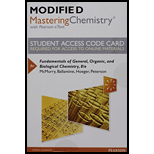
(a)
Interpretation:
The reaction equation for the reaction of p-dichlorobenzene with
Concept Introduction:
Reaction of
Halogenation: The substitution of a halogen group for hydrogen on an aromatic ring.
(b)
Interpretation:
The reaction equation for the reaction of p-dichlorobenzene with
Concept Introduction:
Reaction of aromatic compounds: Unlike alkene, aromatic compound undergoes a electrophilic aromatic substitution reaction where a H atom get replaced by group of atoms.
Nitration: The substitution of a nitro group for hydrogen on an aromatic ring.
(c)
Interpretation:
The reaction equation for the reaction of p-dichlorobenzene with
Concept Introduction:
Reaction of aromatic compounds: Unlike alkene, aromatic compound undergoes a electrophilic aromatic substitution reaction where a H atom get replaced by group of atoms.
Sulfonation: The substitution of a sulfonic acid group for a hydrogen atom on an aromatic ring.
(d)
Interpretation:
The reaction equation for the reaction of p-dichlorobenzene with
Concept Introduction:
Reaction of aromatic compounds: Unlike alkene, aromatic compound undergoes a electrophilic aromatic substitution reaction where a H atom get replaced by group of atoms.
Halogenation: The substitution of a halogen group for hydrogen on an aromatic ring.
Want to see the full answer?
Check out a sample textbook solution
Chapter 13 Solutions
Modified Mastering Chemistry With Pearson Etext -- Standalone Access Card -- For Fundamentals Of General, Organic, And Biological Chemistry (8th Edition)
- draw the alkane strucutre based off the IR spectrum, 1H NMR spectrum, and 13C NMR spectrum for this compound.arrow_forwardFor the following reactions, identify the atom(s) being oxidized and reduced:arrow_forwardWhere in the periodic table are the best reducing agents found? The best oxidizing agents?arrow_forward
- Consider the intermolecular forces present in a pure sample of each of the following compounds: CH₃CH₂OH and CH₃COCH₃. Identify the intermolecular forces that these compounds have in common.arrow_forwardThe standard heat of combustion of liquid methyl cyclopentane, C6H12(l),C6H12(l), was measured to be −3937.7 kJ/mol.−3937.7 kJ/mol. What is Δ?̂ ∘f C6H12(l),ΔH^f C6H12(l)∘, the standard heat of formation of liquid methyl cyclopentane?arrow_forwardBalance the following equation, and tell how many moles of nickel will reactwith 9.81 mol of hydrochloric acid.arrow_forward
- The following equation shows the reaction of baking soda (NaHCO3) and hydrochloric acid (HCl). NaHCO3+HCl → CO2+H2O+NaCl If you have 3.0 grams of NaHCO3, how many moles of HCl are needed for a complete relation?arrow_forwardWhat mass of gallium oxide, Ga2O3, can be prepared from 29.0 g of gallium metal? The equation for the reaction is 4Ga + 3O2 ⟶ 2Ga2 O3.arrow_forwardGiven the balanced equation with an unknown compound represented by X, which compound is represented by X?arrow_forward
- Compare the densities of low-density polyethylene (LDPE) and high-density poly- ethylene (HDPE) with the densities of the liquid alkanes.How might you account for the differences between them?arrow_forwardIn the preparation of aspirin, You can do the functional group test to ensure the completion of the reaction. (a) What is the name of reagent used? (b) What is your observation if any unreacted starting material is present? (c) What is the name of the functional group responsible for this reaction?arrow_forwardPotassium, a silvery metal, reacts with bromine, a corrosive, reddish liquid, to yield potassium bromide, a white solid. Write the balanced equation, and identify the oxidizing and reducing agents.arrow_forward
